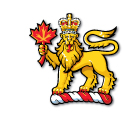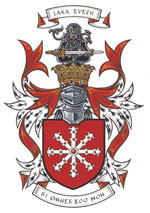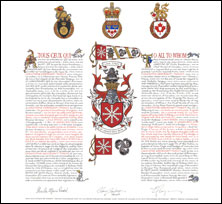- The Governor General of Canada

The contents of this Register are intended for research purposes only. The heraldic emblems found in the Register may not be reproduced in any form or in any media without the written consent of the Canadian Heraldic Authority and/or the recipient.
Christophe Kervégant-Tanguy
Ottawa, Ontario
Grant of Arms, Flags and Badge
November 20, 2009
Vol. V, p. 476
Click on each image to enlarge. The blazon and symbolism for each element will accompany the enlarged image.
Blazon
Arms
Gules an escarbuncle Argent;
Crest
On a coronet treflé Or, a lion sejant affronty Sable holding a sword fesswise Argent hilt and pommel Or;
Motto
LAKA EVEZH;
Motto
SI OMNES EGO NON;
Flag
A banner of the Arms;
Flag
A standard, the Arms in hoist, the fly Argent charged with the Crest and two representations of the Badge, all separated by two bends Or inscribed LAKA EVEZH and S.O.E.N. in letters Sable;
Badge
Three demi-dogs Sable conjoined in triquetra;
Symbolism
Arms
The white escarbuncle recalls the framework of ancient shields, thus evoking the etymology of the Breton place name Kervégant, composed of ker (fortress) and uuicant (combatant, white/sacred). The escarbuncle and its rays represent a precious stone, a ruby that shines so bright that it was traditionally attributed with the alchemic power of shining in the dark like a lantern. Its particular shape also recalls the space of Celtic sacred sanctuaries, which were traditionally bordered by megaliths. This form symbolizes harmony and equilibrium with the dynamism suggested by the red colour of the shield.
Crest
Inspired by the lion appearing on mediaeval Kervégant coats of arms, this lion is shown facing situations head-on and is depicted in black, an emblematic colour of humility, which according to St. Bonaventure is a virtue necessary for transformation. The sword recalls the family’s military tradition and symbolizes action. The coronet on which the lion is seated is inspired by that of the dukes of Brittany to symbolize the quest for sovereignty of oneself, and to recall Mr. Kervégant-Tanguy’s family’s ancestral roots in Brittany.
Motto
The Latin phrase SI OMNES EGO NON, meaning “If all not I”, is a response to the Breton war cry LAKA EVEZH, meaning “Look out!”, with the idea to be always on one’s guard. On the standard, the first letters of each word of the motto form the word SOEN, one of the Breton forms of the forename Yves, honouring Yves de Kermartin (1253-1303), the patron saint of Brittany, renowned for his uprightness and his pursuit of fairness.
Motto
The Latin phrase SI OMNES EGO NON, meaning “If all not I”, is a response to the Breton war cry LAKA EVEZH, meaning “Look out!”, with the idea to be always on one’s guard. On the standard, the first letters of each word of the motto form the word SOEN, one of the Breton forms of the forename Yves, honouring Yves de Kermartin (1253-1303), the patron saint of Brittany, renowned for his uprightness and his pursuit of fairness.
Flag
The symbolism of this emblem is found in other element(s) of this record.
Flag
The symbolism of this emblem is found in other element(s) of this record.
Badge
The three dogs honour the maternal name Tanguy, a Celtic warrior name composed of tan (fire) and ki (dog). The central fret, resembling the tracery of a basket, represents the Greek concept of mètis, meaning wisdom and cunning.
Background
Canada Gazette Information
The announcement of the Letters Patent was made on October 23, 2010, in Volume 144, page 2711 of the Canada Gazette.
Artist Information
Creator(s)
Original concept of Claire Boudreau, Chief Herald of Canada, assisted by the heralds of the Canadian Heraldic Authority.
Painter
Eva Pilar-Cass
Calligrapher
Doris Wionzek
Recipient Information
Individual





